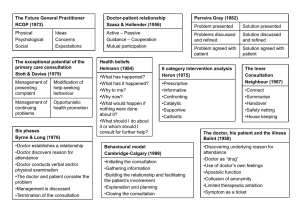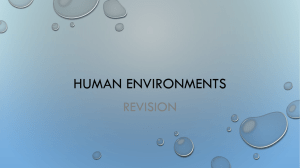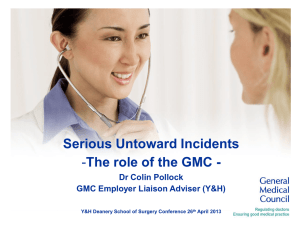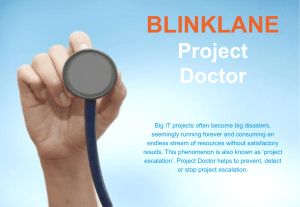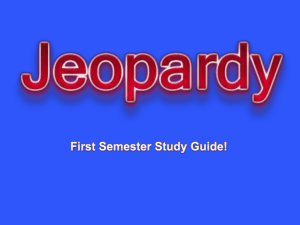Assignment Design for Critical Thinking
advertisement
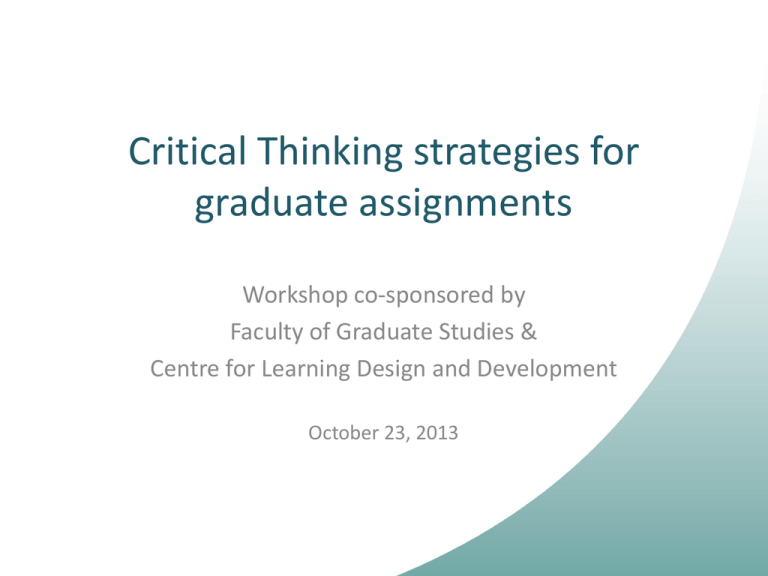
Critical Thinking strategies for graduate assignments Workshop co-sponsored by Faculty of Graduate Studies & Centre for Learning Design and Development October 23, 2013 Agenda • • • • • • • • • 11:00 – Welcome/Roundtable on your perspective 11:10 – Working definition of Critical Thinking 11:15 – Education perspective: Derek Briton 11:25 – Information Literacy/Research perspective: Elaine Fabbro 11:50 – Writing perspective: Linda McCloud-Bondoc 12:15 – Visual organization tips: Corinne Bossé 12:25 – Discussion on Graduate Critical Thinking Activities: Derek Briton 12:40 – Reflections on sample assignments/tips: All 1:00pm – Concluding the workshop 2 Workshop objectives • Provide a working definition of “critical thinking” • Provide a context in which to discuss strategies that support students’ critical thinking skills for graduate assignments • Provide an opportunity to engage in conversation with peers to reflect on critical thinking strategies 3 Learning Outcomes • Raised awareness on multiple perspectives on critical thinking • Reflected on strategies to facilitate the use of critical thinking skills for assignments 4 Your perspective… • In your discipline/experience as an AU student, what do you understand critical thinking to be? • How do you think critical thinking skills should be taught and evaluated in AU courses? 5 Working Definition of Critical Thinking • Critical thinking is a developmental and dynamic mental process which incorporates acts of planning, analysis, evaluation and reflection in applying a set of criteria to solve a problem or answer a question. 6 Van Gyn &Ford (2006) Critical thinking is • A quality of thinking that is characterized by self-regulated deliberations on a challenge situation or task that involve exploring and generating alternatives, and making evaluative judgments. These judgments are based on criteria, which provide justifications for the conclusion, and are applied to meaning, relational, empirical, or value claims (p.11) 7 Teaching Critical Thinking The Far Side © 2000, 2007 FarWorks, Inc. 8 What is Critical Thinking? The Far Side © 2000, 2007 FarWorks, Inc. “Say… what’s a mountain goat doing way up here in a cloud bank?” 9 Education & Critical Thinking The Far Side copyright © 2000, 2007 FarWorks, Inc. 10 Bloom’s Three Learning Domains http://edorigami.wikispaces.com/Bloom's+Digital+Taxonomy 11 Education Perspective 12 Bloom’s Revised Taxonomy http://www.nwlink.com/~donclark/hrd/bloom.html 13 HOTS vs. LOTS 14 http://edorigami.wikispaces.com/Bloom's+Digital+Taxonomy Iowa State Learning Objectives Resource Iowa State Interactive Model of Learning Objectives 15 Information Literacy Perspective • Information literacy is the ability to: • • • • • • Determine the extent of information needed Access the needed information effectively and efficiently Evaluate information and its sources critically Incorporate selected information into one’s knowledge base Use information effectively to accomplish a specific purpose Understand the economic, legal and social issues surrounding the use of information, and access and use information ethically and legally (Association of College & Research Libraries, 2000, 2-3) 16 Thinking Critically About the Research Process Analysis (planning) Evaluation Synthesis (judgment) (reflection) 17 Rethink Revise Repeat 18 Self-Reflection on the Research Process • How do you normally approach a research assignment? • What strategies work or don’t work? 19 Thinking Critically About the Research Process • • • • Strategies for Understanding Assignments Research Journal Pose Questions Taking Notes 20 Strategies for Understanding Assignments • • • • • What are the key concepts? What is your topic really about? Restate the research topic in your own words Rephrase your topic as a question What other words can be used to describe the concepts in your topic? 21 Sample Research Journal Search Terms Concept 1 Treating treatment cure therapy rehabilitation Concept 2 Children Child youth infants kids Concept 3 Autism Autistic Search Strategies 1 treating and children and autism 2 (Treatment or therapy) and (children or infants) and autism 3 (treatment or cure or rehabilitation) and (child* or youth or kids) and (autism or autistic) Databases Searched PsycARTICLES Search Strategy Used # of Results Retrieved 1 Comments Large number of results, need to narrow search, results do not seem to be 1674 specific enough 22 Evaluating a Search • What do I consider a “successful search”? – – – – Relevant results on my topic Recent results Appropriate number of peer reviewed sources Results from experts in the field 23 Evaluating a Search • How many results were retrieved? Many? Few? What does that mean? (Good/bad search?) • What types of results were retrieved? Scholarly, peer reviewed, magazines? • How recent are the results? • Do any results appear (at first glance) to be relevant? 24 Evaluating Resources • Does the resource answer your question or help you to understand it better? • Does the resource support your point of view? • Does the resource cover the right time period? • Is the resource appropriate to your level? • Does the resource meet the publication date range specified in your assignment? • Is the resource scholarly or peer reviewed and does it match the requirements of your assignment? • Does the author of the item appear to be an authority on the topic? 25 Reading Critically • What problem or issue is the author addressing? • Is the problem or issue clearly identified? • How does the author make their argument (e.g. by appealing to emotion, objectively etc.) • Is their bias in the argument and what is it? • How is the argument laid out or structured? • What contributions does the item make to your specific information need? • How does this document relate to other literature you have read? 26 Taking Notes • Make note of the complete citation! • Identify where you found the item (e.g. name of specific journal database, AU Library Catalogue, Web, etc.) • Develop a strategy for identifying your own thoughts in your notes • If you are capturing important quotes, mark them as such and include the page number 27 Critical Thinking from an Academic Writing Perspective • A developmental and dynamic mental process, with parallels to the academic writing process, built on intellectual habits of mind, • characterized by acts of judgment, planning, deliberating, justifying, challenging and self-correcting, • and aimed at applying a set of criteria to solve a problem or answer a question . (Paul & Elder, 2005; Toulmin in Golden, Berquist & Coleman, 1998; Van Gyn & Ford, 2006 ) (Paul & Elder, 2005; Toulmin in Golden, Berquist & Coleman, 1998; Van Gyn & Ford, 2006 ) 28 Critical Thinking from an Academic Writing Perspective • The act of challenging assumptions and coming to conclusions through systematic inquiry (Paul & Elder, 2005; Toulmin in Golden, Berquist & Coleman, 1998; Van Gyn & Ford, 2006 ) 29 The Critical Thinking/Academic Writing Connection Stephen Toulmin’s rhetorical model: one way to a clear thesis Since Evidence Conclusion (Golden, Berquist &Coleman, 1989) 30 The Critical Thinking/Academic Writing Connection Stephen Toulmin’s Model of Argument Evidence: more people have rated him positively on “Rate my Doctor” Since: “Rate my Doctor” is a good measure of a doctor’s skills Conclusion: Therefore, Doctor A is better than Doctor B 31 The Critical Thinking/Academic Writing Connection Probably Unless Because (Golden, Berquist &Coleman, 1989) 32 The Critical Thinking/Academic Writing Connection Unless some patients were not fair in their comments Probably Evidence: More Since “Rate my Doctor” is a good people have rated measure of a doctor’s skills him positively on “Rate my Doctor” Therefore, Doctor A is better than Doctor B Because research shows that sites like “Rate my Doctor” are reliable sources of information on a doctor’s medical and interpersonal skills 33 The Critical Thinking/Academic Writing Connection Dr. A is probably a better physician than Dr. B because he was rated more highly on “Rate my Doctor” (unless some patients were not fair in their remarks about Dr. B) since “Rate my Doctor is a good source of information about a doctor’s skills because research shows that sites like “Rate my Doctor” provide a reliable reflection of a doctor’s medical and interpersonal skills. 34 Critical Thinking and Academic Writing Processes Planning/Prewriting •Asking good questions/Pre-reading •Identifying biases/underlying assumptions/Identifying key questions •Identifying problems/issues/questions/ Self –Correcting/Final Draft Deliberating/Outlining •Reflecting on the quality of CT •Refining the thesis •Assessing the argument •Tightening the logic/flow •Editing for grammar/meaning •Analyzing and synthesizing ideas •Drawing original conclusions/ •Formulating a thesis •Outlining and organizing the text Challenging/Second Draft Justifying/First Draft •Critically evaluating sources •Selecting criteria for evaluation •Asking good questions of the material •Revising for content/arrangement •Offering good evidence/ Refining the thesis •Testing reasons •Testing conclusions/ Organizing the text Adapted from “Critical Thinking Competency Standards: Standards, Principles, Performance Indicators, and Outcomes with a Critical Thinking Master Rubric” by R. Paul and L. Elder, p. 20-55. Copyright 2005 by Foundation for Critical Thinking. 35 The Critical Thinking/Academic Writing Connection • “Although we can think without expressing our ideas, we cannot write well without thinking…[Thinking] provide[s] the substance of composition” (Ruggierio,1998, p.233). • Characteristics of substantive composition: – – – – Unity Coherence Emphasis Development 36 Substantive writing through paragraphing Topic (sentence) Supporting evidence, ideas Point about the thesis Adapted from “How to Write a Paragraph: The Art of Substantive Writing” by R. Paul and L. Elder. Copyright 2003 by Foundation for Critical Thinking 37 Example of a substantive paragraph Although these sites may give some indication of a doctor’s interpersonal skills, research indicates that they do not supply reliable information about a doctor’s medical skills and may actively harm existing doctor-patient relationships. Not only are the comments on sites like “Rate my Doctor” questionable, some research shows that they could damage the doctor-patient relationship. For example, Smith (2011) , in a survey of 300 Canadian physicians concluded…In addition, Brown (2012) demonstrated… This research suggests that if a patient has an existing, good relationship with a doctor, sites like “Rate my Doctor” can lead to mistrust of the physician and noncompliance with treatments. 38 Outlining Conclusion/Thesis: Sites such as “Rate My Doctor” do not supply reliable information about a doctor’s medical skills and may actively harm existing doctorpatient relationships, although they may give some indication of a doctor’s interpersonal skills.” Intro Section 1-Why these sites do not supply reliable information PARA 1a-They are not reliable because of commentators’ lack of medical knowledge PARA 1b- They are not reliable because… Section 2-How they actively harm existing doctor-patient relationships PARA 2a- SAMPLE PARAGRAPH PARA 2b- These sites can lead to non-compliance with treatment… Section 3-Why and how the sites give indication of doctors’ interpersonal skills PARA 3a-Why PARA 3b-How Conclusion 39 Principles for learning CT through writing • CT feeds well structured, developed, logical writing and vice versa. • Sharpening the focus and organization of a piece of writing helps to sharpen critical thinking on a topic. • “Writing to think” and “thinking to write” i.e., focusing on paper’s thesis/conclusion, development, organization and the quality of the argument are mutually supportive skills. • The development of thinking is evident in the drafting process of a piece of writing. • Writing is a way of engaging in critical dialogue with oneself and one’s audience. 40 Checks for demonstrating CT through writing • Have you used your drafting process to think through to your conclusion systematically, using a system and set of criteria that are appropriate to the discipline and the assignment or writing occasion? • Have you done multiple drafts, keeping in mind that remember there is no good writing, only rewriting? • Have you planned enough time for your thinking, reflection, and drafting? • Have you maintained coherence, unity, development and proper emphasis in your paragraphs and in your sections? • Have you used an outline (or some kind of prewriting) to check the connections between the sections and your conclusion? • Do your paragraphs and sections lead your readers closer and closer to your conclusions? 41 Tips for visual organization of your work • Use of visual analytical tools to express your ideas: – – – – – – Concept maps Charts Thematic matrices Tables Figures Etc. 42 • 43 Stages of Teacher Development 44 45 46 47 48 Interactive Infographics 49 Discussion: Graduate Critical Thinking Activities Reflective Analysis • Word Limit: 1,250 maximum (6 double–spaced typed pages) • Choose from the assigned (cultural history) readings what you consider to be a pivotal, transitional period/event/personage. • Then discuss your chosen subject in three parts consisting of a description, an analysis, and a reflection. 50 Reflective Analysis • Description (15–25% of the exercise): • Start out by briefly describing – a. the social relations (how society was structured) – b. the political relations (who held or shared power and how that power was legitimated) – c. the cultural relations (the Zeitgeist or cultural/intellectual mood of the time) prior to and after the transition/event 51 Reflective Analysis • Analysis (50–60% of the exercise): • Decide which of the three areas of relations (social, political, cultural) was responsible for the change(s) that triggered the transition and provide an analysis (a rationale and textual evidence) in support of your position. In your analysis, consider the question of whether this transition was an inevitable stage in the development of Western civilization, or the result of one or a series of contingencies that only appear inevitable in retrospect. 52 Reflective Analysis • Reflection (10–15% of the exercise): • Conclude your analysis with a reflection on why you feel it is advantageous to consider questions such as this from an interdisciplinary perspective. • Please pay particular attention to the proportion of the exercise’s three elements: – Descriptive (15-25%) – Analytical (50-60%) – Reflective (10-15%) Do not submit papers that are purely or primarily descriptive as a Reflective Analysis. 53 Reaction Papers • (in response to an assigned reading) • Word Limit: 250–500, unless otherwise specified by the course professor • In developing your Reaction Papers, you might choose one or more of the following strategies: 54 Reaction Paper • Challenge the construction of the argument, the definitions or concepts, the evidence supplied, the presence of logical fallacies, or the theoretical framework. • Relate the material discussed in the reading to other courses or other contexts. • Relate the material discussed in the reading to your own life experiences. • Identify something in the reading that you were surprised to learn, or found interesting or unexpected, and recount why. • Identify controversial, contentious, or debatable points, and offer credible counter arguments. 55 Reflections: Critical Thinking Tips 56 THANK YOU! 57 Evaluation • What did you learn today? • What did you like about the workshop? • What recommendations do you have for next time? • What other concerns do you have about teaching and learning at AU that we could address in a workshop? 58 References: Writing Perspective Brookfield, S. (2012). Teaching for critical thinking: Tools and techniques to help students question their assumptions [Kindle book]. San Francisco, CA: Jossey-Bass . Bean, J. (2011). Engaging ideas: The professor’s guide to integrating writing, critical thinking, and active learning in the classroom. San Francisco, CA: Jossey-Bass. Kneupper, C. W. (1978). Teaching argument: An introduction to the Toulmin Model. College Composition and Communication, 29(3), 237–241. doi:10.2307/356935 Paul, R. & Elder, L. (2003). How to write a paragraph: The art of substantive writing. Dillon Beach, CA: The Foundation for Critical Thinking. Paul, R. & Elder, L. (2005). Critical thinking competency standards: Standards, principles, performance indicators, and outcomes with a critical thinking master rubric. Dillon Beach, CA: The Foundation for Critical Thinking. Golden, J., Berquist, G., & Coleman, W. (1989). The rhetoric of western thought (4th ed.). Dubuque, IA: Kendall/Hunt Publishing Company. Van Gyn, G. & Ford, C. (2006). Teaching for critical thinking. London, ON: Society for Teaching and Learning in Higher Education. Ruggerio, V. R. (1998). The art of thinking: A guide to critical and creative thought (5th ed.). Reading, MA: Longman. 59 References: Information Literacy Association of College & Research Libraries (2000). Information Literacy Competency Standards for Higher Education. Retrieved from: http://www.ala.org/acrl/sites/ala.org.acrl/files/content/standards/standards.pdf Athabasca University Library. (2012). Writing a Literature Review. Retrieved from: http://library.athabascau.ca/help/LitReviewGuide.php Bean, J.C. (1996). Engaging ideas: The professor’s guide to integrating writing, critical thinking, and active learning in the classroom. San Francisco: Jossey-Bass. Grassian, E.S. (2009). Information literacy instruction: Theory and practice (2nd ed.). Chicago: Neal-Schuman. Halpern, D. F. (1999). Teaching for critical thinking: Helping college students develop the skills and dispositions of a critical thinker. New Directions for Teaching and Learning, 80, 69-74. Kop, R. (2012). The unexpected connection: Serendipity and human mediation in networked learning. Educational Technology & Society, 15(2), 2-11. Ruggiero, V. R. (2009). Becoming a critical thinker (6th ed.). Boston: Houghton Mifflin. 60 Useful Research Tutorials Searching the AU Library Catalogue: http://aupac.lib.athabascau.ca/screens/help_index.html Finding Journal Articles in the Library’s Collection (AKA AU Journal Title List Tutorial) : http://library.athabascau.ca/help/jportal/ejportal_viewlet_swf.html AU Library Guide to the Research Process: http://libguides.athabascau.ca/researchprocess Internet Searching: http://libguides.athabascau.ca/internetsearching Searching Google Scholar for AU Library Resources: http://library.athabascau.ca/help/tutorials/googlescholar/googlescholar.html Tips for Searching: http://libguides.athabascau.ca/booleansearching Writing a Literature Review: http://library.athabascau.ca/help/LitReviewGuide.php 61 Useful Resources: Visualization tools • AU e-lab: http://tools.elab.athabascau.ca/category/tool-entry/visualization-tool • Educational Inquiry Concept map: http://eddcna.files.wordpress.com/2010/05/bubblus_educational_inquiry.png • Interactive Infographics: http://infogr.am/ • Novak, J. D. & A. J. Cañas, The Theory Underlying Concept Maps and How to Construct Them, Technical Report IHMC CmapTools 2006-01 Rev 01-2008, Florida Institute for Human and Machine Cognition, 2008", available at: http://cmap.ihmc.us/Publications/ResearchPapers/TheoryUnderlyingConce ptMaps.pdf 62

